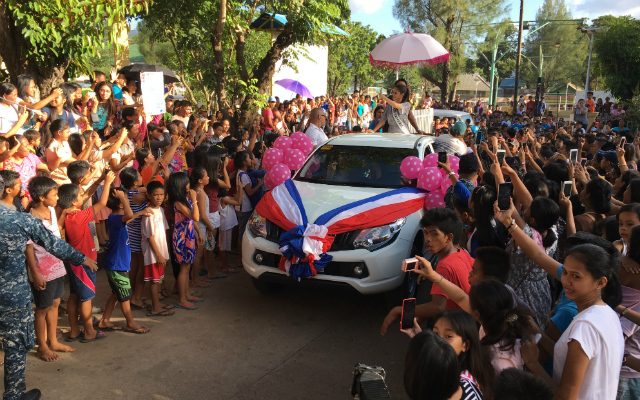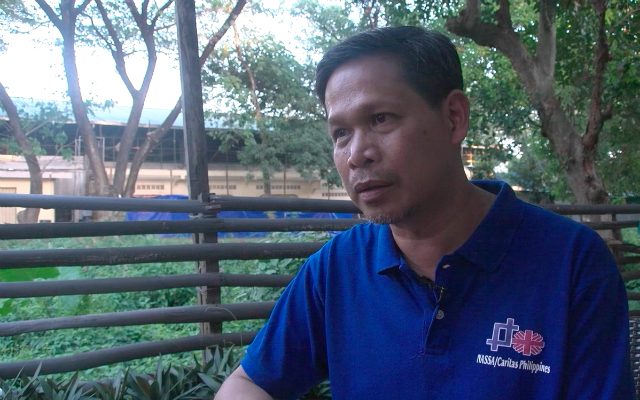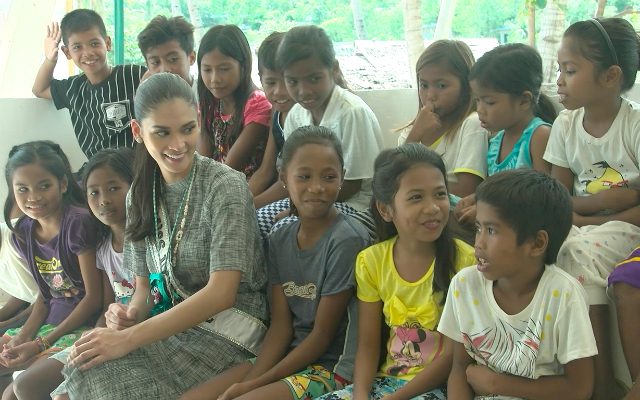SUMMARY
This is AI generated summarization, which may have errors. For context, always refer to the full article.

PALAWAN, Philippines – Reigning Miss Universe Pia Wurtzbach’s visit to the resort-town of Coron on Saturday, January 21, highlighted two of the biggest issues facing the province – climate change and indigenous peoples’ (IP) rights.
Wurtzbach visited Barangay Malawig – a Tagbanua village that was heavily damaged when Super Typhoon Yolanda (Haiyan) struck in November 2013 – to see the rehabilitation and recovery programs of the Catholic Organization for Relief and Development Aid (CordAid) for the community.
According to Shane Naguit, a community facilitator of the Samdhana Institute, the intervention in the community was unique because it was not a typical dole-out program.
“The non-government organizations that responded to the Tagbanua communities – unlike the government which was more focused on relief – were more focused on developing the resiliency of these communities so that if another disaster happens in these communities, they will be more prepared and not depend on outside help,” Naguit told Rappler.
In Malawig, aside from building houses and infrastructure after the typhoon, CordAid and its partners empowered the communities to create their own disaster contingency plans, and provided ways for the residents to have livelihood.
“The disaster plans they made themselves used their indigenous structure that is more resilient to typhoons compared to the models introduced by other agencies,” Naguit said.
She added: “Food security is another factor to consider for resiliency of communities. An example we saw in the community was that they have an indigenous crop called ‘kurot.’ This root crop can withstand typhoons and long dry seasons. It’s a very resilient crop that helps ensure food security in the community.”
CordAid helped build more than 200 typhoon-proof houses and 30 community-managed projects like bridges, schools, and daycare centers. Miss Universe Organization was one of the benefactors. (READ: How Tagbanua communities in Coron recovered from Yolanda)
A fight for IPs

The IP community in Malawig said it was empowering to see someone so well-known give attention to their simple lives.
“We were surprised that we’re the only community she chose to visit in Coron. We saw that she knows how to be with us simple people. We thank her for the support,” village elder Clemencio Carpiano said.
For Fr Edwin Gariguez, executive secretary of the National Secretariat for Social Action – Justice and Peace (NASSA), the visit should put the spotlight on the rights of IP communities in Calamian Islands, where Coron is.
“In some of the communities I visited, the IPs’ lands were slowly being taken away. Our indigenous groups, when you take away their ancestral domain, they have nowhere to go. Their lives are linked to their lands,” Gariguez told Rappler.
While tourism is a good thing for development, Gariguez added that it should not be at the expense of IP communities.
“Because of the influx of tourists, some projects push away IP communities, especially those near pearl farms, for example. We need to protect our IPs and implement the Indigenous Peoples’ Rights Act to help them solidify their claims for their ancestral domains,” he said.
One of NASSA’s initiatives is to help IP communities get titles for their ancestral lands.
The status of IPs’ ancestral lands in the Calamian Islands is still in limbo, as Naguit explained.
“All the Calamian Islands are ancestral domains of the Tagbanuas. So far, there are only two communities that have been awarded the title. There are 23 barangays still applying for titles,” she explained.
Resiliency in their own land

For the National Commission on Indigenous Peoples (NCIP), resiliency for IPs means being able to empower them in their own ancestral domains.
“Our indigenous groups, when you take them away from their ancestral domains, they won’t be indigenous anymore. They can’t live outside their lands. Even if you bring them to Manila or to the city, they will not thrive. They will always go back,” said Conrado Balbutan, NCIP tribal affairs assistant.
Gariguez also said: “This is why we must make sure that they stay and get titles to their ancestral lands. Because no matter how many projects you implement, if they will be kicked out of their lands without livelihoods and nowhere to go, it’s pointless.”
During Wurtzbach’s Saturday visit, the Tagbanua community presented indigenous dances and songs to the beauty queen. They fed the guests with crops planted in the communal farms.
According to Balbutan, this is an empowering moment for the Tagbanua in Coron.
“This will serve as a challenge for them to strengthen their bond as a tribe and their pride as Tagbanua. Being proud when facing the mainstream is a big thing for indigenous peoples,” he said. – Rappler.com
Add a comment
How does this make you feel?
There are no comments yet. Add your comment to start the conversation.